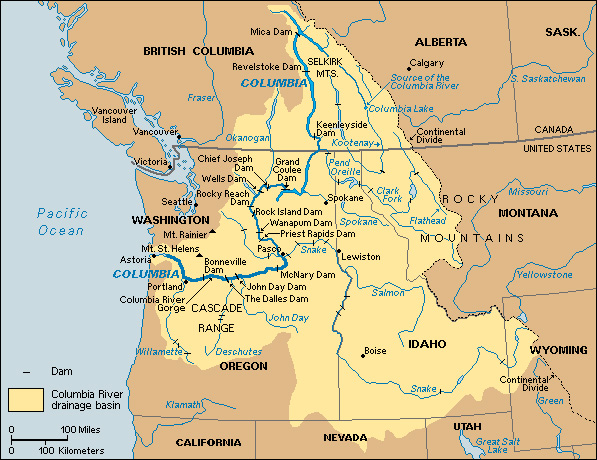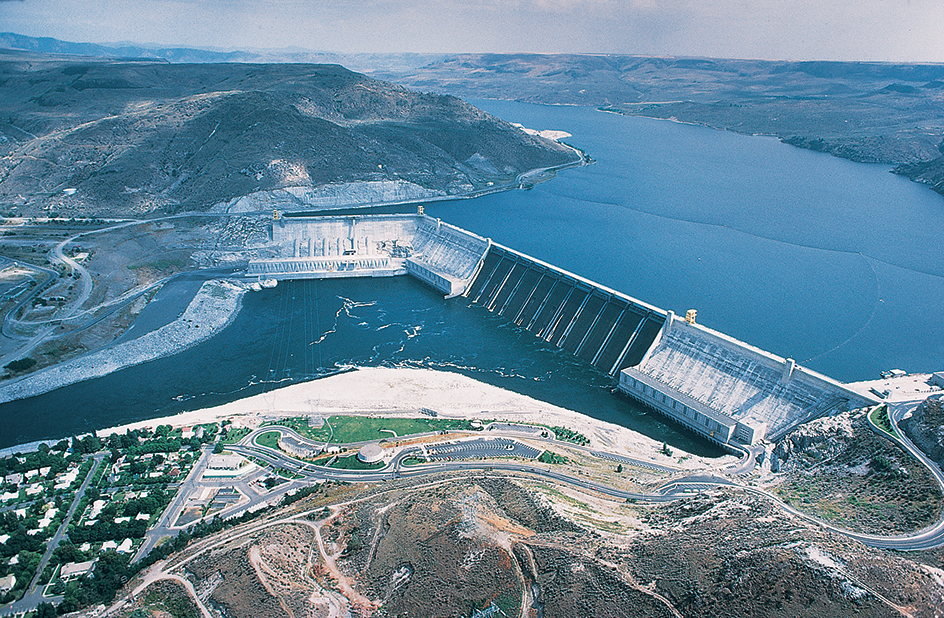Columbia River is one of the chief rivers of the Western United States and Canada. It is the second longest river in the Western Hemisphere that flows into the Pacific Ocean. Only the Yukon River is longer. The Columbia is 1,243 miles (1,995 kilometers) long. It drains an area of about 250,000 square miles (647,000 square kilometers), mostly in the United States.

Dams on the river generate about a third of the hydroelectric power produced in the United States. The Columbia also is an important transportation route and a major source of water for irrigation.
The Columbia was named by Captain Robert Gray of Boston, who sailed into the mouth of the river in 1792. Gray named the river for his ship. In 1805, the American explorers Meriwether Lewis and William Clark traveled down the Columbia during their historic expedition to the Pacific Coast. In 1811, the Canadian explorer David Thompson became the first white person to navigate the entire length of the river.
The course of the Columbia.
The Columbia River begins in Columbia Lake, which lies in the southeastern part of the Canadian province of British Columbia. From there, it flows northwest for about 200 miles (320 kilometers), bounded by the Canadian Rockies on the east and the Selkirk Mountains to the west. The river curves around the Selkirks and then flows south to the Canadian-U.S. border. About 100 miles (160 kilometers) after entering the state of Washington, the Columbia begins a large curve westward. As the river continues to flow west to the Pacific Ocean, it forms the boundary between Washington and Oregon. The river passes through the Cascade Range by way of the Columbia River Gorge. The mouth of the Columbia forms a deep harbor on the Pacific Coast. Astoria, Oregon, an important fishing port, lies at the mouth of the river.
Hydroelectric power and irrigation.
Fourteen large dams on the Columbia–11 in the United States and 3 in Canada–provide water for hydroelectric power and irrigation. Grand Coulee Dam, about 90 miles (140 kilometers) northwest of Spokane, Washington, is the greatest single source of water power in the United States. Inexpensive electricity produced by the Columbia River dams has encouraged industrialization in the Pacific Northwest, including aluminum plants along the river and aircraft factories in Seattle and other cities in Washington. Irrigation water provided by the dams has turned millions of acres of arid land into a productive farm region. Also, reservoirs created by the dams are used for boating, fishing, swimming, and other activities. Dams on the Columbia’s tributaries also control flooding by the river.

Commerce.
Large ocean vessels travel on the Columbia between the Pacific Ocean and Portland, Oregon. Smaller vessels go from the ocean through the locks of Bonneville Dam and continue up the river to Pasco, Washington. Canals and lock systems also permit barges to use the lower part of the Columbia and sail up the Snake River as far as Lewiston, Idaho, more than 450 miles (720 kilometers) inland from the Pacific Ocean. Barges on the Columbia carry such cargoes as grain, forest products, and petroleum.
Wildlife
of the Columbia River includes such fishes as perch, salmon, and trout. In the Canadian Rockies, forests of fir, larch, hemlock, and spruce trees grow along the river. These mountain areas are the home of bears, bighorn sheep, moose, and timber wolves. Bobcats, coyotes, and elk live in the grasslands that border the river in the United States.
